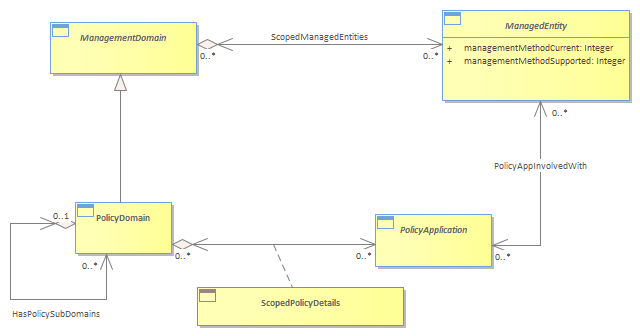Figure 1P-20 - PolicyApp Interactions

|
Project:
|

Figure 1P-20 - PolicyApp Interactions : Class diagram
The purpose of this section is to describe how policy can be used to build a policy based management system. <br/>A PolicyApplication is a special type of entity for use in policy-based management applications.<br/>The ScopedManagedEntities aggregation defines the set of ManagedEntities that are contained in a particular ManagementDomain. <br/>The ScopedPolicyApplication aggregation defines which PolicyApplications are scoped by a particular PolicyDomain. This is an important concept, as this controls what PolicyApplications can work on what ManagedEntities. Note that containment in a ManagementDomain implies the ability for said ManagedEntities to be managed by a particular PolicyApplication. The HasPolicySubDomains recursive aggregation enables hierarchies of PolicyDomains to be constructed. This is particularly useful for associating organizational hierarchies to PolicyApplications.<br/>The logic behind scoping in general, and the ScopedPolicyApplication and ScopedManagedEntities aggregations, is complicated and not suitable to a business discussion.<br/>The PolicyAppInvolvedWith association defines the set of PolicyApplications that are involved with processing policy decisions and performing policy actions on a set of ManagedEntities. Note that this association does NOT imply an action being taken on a ManagedEntity. Rather, it shows that a PolicyApplication is involved with applying policy to a particular ManagedEntity. For example, a policy-based management system may be measuring the performance of a particular ManagedEntity, so that policy can be used to change its configuration if the performance violates an associated SLA. The monitoring PolicyApplication is not applying actions to the ManagedEntity – rather, it is performing monitoring on the ManagedEntity so that another PolicyApplication can correct the operation of the ManagedEntity if needed.<br/>
|


